#Label Printer and Applicator
Explore tagged Tumblr posts
Text

When choosing the best automatic label printer and applicator for your business, several factors must be considered to ensure efficiency, quality, and cost-effectiveness.
Product & Labels information
Application information – Label location and photo
Transmission device and photo
Signal/Sensor
Maintenance and Support
Cost and Return on Investment (ROI)
#Label Printer and Applicator#Integrated Labeling Machine#Automated Labeling System#Labeling Equipment
0 notes
Text

but i don't want a complete enterprise solution just sell me the damn printer
#zebra#i'm in the market for a label printer that's linux/network compatible#preferably network#will need support for a wide variety of label dimensions#basically i don't have a well-defined application and want something that can handle anything in small batches#and ideally isn't a pain in the ass
0 notes
Note
Hi, I was wondering if you have resources or examples of what system mapping is/looks like? My therapist mentioned it and I don't really understand what that ... looks like. And also can't find any real resources on it
System mapping refers to a lot of record keeping, more so than most people think of when they hear about it. The most common route for this exercise is a visual aid, often done on blank printer paper or with a computer application that allows for shapes with text in them.
Some goals for system mapping can be seeing how system members
are related (who knows who, how they interact with one another, how they define their connections)
came into the system (who split from who, when they showed up, what happened to get them)
fit into the collective (who’s similar or different, how roles make sense, where triggers chain together)
exist in space (how close to one another they are, where things are in the internal world, how visualized barriers come into play)
are themselves (which labels they use, which things they like and dislike, how they exist as one being and a member of a group)
Here are some examples of maps for each of these things





I did these taking only a few minutes each, and they’re simplified versions of real maps we’ve done in the past. Maps should be thought-provoking, a dumped box of ideas you connect on the page. Sometimes it takes hours (or days, but that’s usually an avoidance problem).
We’re working on one right now that shows when different color codes came into play for us. Our system is huge, so this is a broader project that doesn’t address individual members or subgroups. We took a poster paper and some colorful pens, made some notes at the top, and are drawing a garden with a central tree and some flowers for pieces that don’t make sense as a branching out. We worked on it several hours straight, redid it twice, and it’s still not done.
Our largest system map is a wall of post-its hanging on for dear life, with different color notes and ink for different purposes. We have a whole legend of symbols and would probably be using pins and yarn if we had a cork board. That one is everything; people and places, subgroups and relationships, programming and trauma, all of it.
If you(&)’re looking for resources, I have like two links I know I can find right now. Mostly this is a community topic, and you can watch people make maps on video sites like YouTube or TikTok. You’re less likely to find academic material about system mapping unless you’re looking for discussion about treatment or plain case studies, and I dislike contextualizing the exercise like they do.
I like the first link because they’re creative with it, which is great for visual aids. They also remind you that mapping isn’t for everymany/body, and that it’s okay not to do it or not include everyone.
The second isn’t specific to mapping, but has a bullet list I liked from another site that was more commercial.
A third one I thought about including but didn’t had some good reasons for mapping for integration (helping each other notice they’re connected, that there are reasons the system works like it does), but was more clinical.
Actually, I feel bad explaining it and not showing it, so you(&) choose if that sounds okay to you.
There are many larger articles which include aspects of system mapping, but reading them requires a lot of sifting and determining what is real to you(&) before you can make use of most of what’s written. It can help form opinions, and it will also send some cascading. If you look into the academic side, remember to look into the community side, too. You need both, just maybe not as early as mapping the system for the first time.
Poster paper is system mapping. Sand trays are system mapping. Roll calls are system mapping. Community meetings are system mapping. System mapping is getting to know your(&) system. You can’t really do it wrong, but I hope you got some ideas of where to start.
22 notes
·
View notes
Text

Blog No.004📚 24年6月13日
My Visual Method of Learning Japanese Kanji (漢字) part①
~ Let's Pair-up Similar-lookin' Characters Next to Each Other♥!~
There are many ways to learn Japanese. 📔
This way might not be effective or efficient (or even reasonable) for anyone else, but this is the visual approach that I'm currently developing + sharing for possibly any like-minded students it might resonate with!
Edit: It's all cleaned up for HD download on my ko-fi shop for free!
【Background】
At first, I did the standard 'write it down with repetition until you get it right' on flashcards, notebooks, etc. and I don't think I ever got it 'right'ーevery optimistic attempt of "I'm gonna get in some daily lessons in today and successfully absorb this knowledge once and for all!!" was always accompanied with this state of... confusion? and being so, so overwhelmed that neither the meaning, the reading, the stroke order, nor even the appearance of the kanji stuck to me at all. I don't think I've ever made it past the list of N4 kanji, even though most words I come across tend to be scattered around the N3-N1 level whenever I check the dictionary.
I've tried studying them strictly in order of the listing / then tried loosely with some doodling / or even a cherry-nitpicky minimalistic approach; just-take-what-is-frequently-used-style... but there just seemed to be no end in sight. It's been a decade, and I still do not know a lot kanji。
『Issue①:』 I wanted to see ALL of the kanji displayed at once, instead of dreading the 'higher levels' hidden from the limited amount displayed at a time; be it from reference books, screen displays on websites or mobile applications, etc. It's definitely just a personal issue, I think haha I just didn't like the surprise sneak attack from so much identical kanji from differing levels that scrambles my brain everytime I encounter a doppelganger. And boy, there's a LOT of those (as you will see).
I thought about making a series of biiiig posters or scrolls I could stick up on a wall, like those kiddie info posters but completely filled with kanji as decoration + motivation + and a bit of a cheat sheet I could easily access at a glance. But just imagining over 2,000 jumbled characters looming over me while I work on my desk or seeing something like that first thing after waking up………feels a lot unsettling, I think-
『Issue②:』 They're often arranged according to their frequency of usage, stroke order, or general difficulty of the word. Although it's for practicality, it leaves the visual impact completely all over the place. I don't know if I have any underlying conditions that contribute to something trivial like this greatly bothering me past the point of productivity, but it's not even about aesthetics I have an issue with, I don't think? It's just...the arrangement feels so chaotic, or sometimes oddly restrictive that I keep getting distracted. It's like some kind of puzzle I've been trying to solve for 10 hours straight, but it's just me going in circles back to zero. Speaking of puzzles....
Maybe, to save physical space for literally thousands of characters, I thought about placing one kanji on each of a rubik's cube's faces. But that would take a ridiculous amount of cubes and printer ink/alternatively, manually cutting, pasting, and poorly writing very very tiny 0.5inch labels for...two thousand times, at least. By hand.

I'm still tempted to incorporate this idea in some way, but felt unmotivated and lazy with how flimsy and shoddy my handwritten labels were…also printer ink prices continue to be a goddang scam--
I've unfortunately never been a studious student, especially not when it comes to conventional learning methods. It tends to make me want to try ridiculous ideas to get around my own dysfunctionality, because the other option would be... to continue a system that doesn't work and be frustrated, and accomplish nothing; not even a smile.
I am learning Japanese out of my own free will, so I wanted to have fun with itーbecause the whole concept of kanji seems really fun in theory!�� but not so much in attempted practice as a clueless outsider with no knowledge or means apart from the standard English reading and writing system. I'm a little envious of my chinese friends also learning Japanese having a bit of a headstart with the writing system's origins...
Even if perceived as a complete waste of time by a lot of people, I still want to understand each individual character to be able to appreciate and greet them accordingly when I encounter them in the wild.
For fun☆!
【Conventional Systems】
For this project, I mostly took inspiration from other existing popular learning systems that many people use:
➊The standard N5-N1 System was alright, but I found myself tempted to skip straight to ~N3 where frequently used characters appeared more, despite being barely at the lowest N5 proficiency level myself. I wanted all the characters to be visibly accessible…but it got intensely overwhelming so fast. The hierarchal labeling also made finding a N1 character have this weird sense of pressure? Like, "oh sht , this word has N1 kanji. mY ELEMENTARY GRADE DUMBASS AIN'T SUPPOSED TO BE IN HERE--"

➋Then there's the pictograph potential. It's interesting, but I thought a lot of them were a little bit of a reach? haha it's basically a visual mnemonic, right? But other people's mnemonics usually have their 'creative logic' that my own may not agree with, so I just end up getting distracted with the internal logic of the image and how it correlates to the kanji instead of absorbing any actual information. I think it has potential, but I'd need to personalize the visual imagery for it to be effective…or at least, have the mnemonic make enough sense to me and not be abstractly distracting. Even by then, the more strokes there are, the more convoluted it looks to even liken it to anything in the real world...Kanji by itself is already a pictogram, I guess...?

➌Then there's the beloved Heisig method. I liked the concept; the goal is for (mostly) foreigners to easily familiarize the 'look' of the kanji character and attach it to a singular meaning. But personally, it wasn't working with how much my brain was confusing every variation of similar-looking patterns that kept reappearing over a span of different pages of kanji, with the same radical appearing in different positions or orientations. Heisig's compilation was good in a sense that I could see a reoccurring pattern and it was most definitely less chaotic to look at now, but they continue to persist so far away from each other? Then adding that element of "the unknown" with kanji I've yet to encounter or seek out for being 'too advanced' with this doppelganger dilemma was driving me absolutely coconuts.
Plus, since it's a method created with absolute beginners in mind, it falls short with the lack of kun- and on- yomi readings…which were what I needed to learn the most.
I decided to combine these three ideas to make my own way.
【??? Personal System】
This system will continuously be developed from here on out until it can actually be functional, but so far, here's what's been done and being planned:

Apparently these were taken from 8+ months ago good lord-
I pretty much just lined up screenshots of a full kanji listing (I believe it was a Jouyou listing with some obsolete characters removed) and just...painstakingly played a Match-3 game, but irl, pretty much... and with more back pain
※Reference used to curate these kanji and their information are primarily from ①an app called 'Satori', and ②another app called 'Yomiwa'. Both apps source information from KANJIDIC and JMDict + mixed with a variety of online dictionaries to cross-reference and check for additional info.
I was working on and off on it because staring at nothing but kanji all day will probably make a few screws loose, but I generally continued anytime I was feeling a little down, stressed out, or just had free time. It was oddly therapeutic when I saw the finished arrangements, though. This feeling of "I can't tell if I like it or hate it" reminded me of my thesis days lmao

I had originally planned to put them on 3x3 rubik's cubes, so I initially had to group them by a full set of 9 characters. But the distribution was so unbalanced that each look-alike group was either lacking or exceeding in numbers, and trying to evenly incorporate 'leftovers' into the other groups just looked forced as hell, visually. So, I gave up on the rubik's cube concept and just tried to match at least a row of just 3 look-alikes to then ascend or descend in complexity with their other cousin-distant-lookalikes.
EXAMPLE:
人 大 木
person・big・tree
▲These three I would consider 'cousins'. I wouldn't classify them together in a row of 3 because there are far more identical characters, but after I gather all of each of their sibling groups, I'd most definitely arrange them next to each other in succession as if the 人 was growing more limbs.
太 大 犬
fat・big・dog
▲These three I would consider 'siblings'.
It reminds me of twins that only have differing beauty marks for distinction.

▲And these...are kinda cursed ngl, my double takes had to do their own double takes everytime I would finish grouping something to the 'tree radical' family, and suddenly spotting another one I could've sworn was the exact same character. It made me feel like I was going insane lol I know that the context showing the connecting hiragana is usually a dead giveaway on which kanji it is, regardless of how similar in appearance + how it's going to be read... but man. It's so surreal seeing them all lined up next to each other?? All I see is a forest-
Somewhere along the way, my brain remembered about the elemental periodic table and drew some layouting inspiration from there, too. Ideally, I would love to have all the information already present at a single glance with each character. But with the limited display space... assigning a chronological identification numbers on them for now is all I can do to help in navigating this wide, colorful kanji blanket.
I might've discarded a couple of archaic / overly complex kanji that no one really uses for this list at this moment, but in total, there appears to be 952 rows of trios. I may add or even remove more in the future.
= A total of 2,856 kanji have been included. Unless I miscounted somewhere-
my back hurts-
【Personal Limits + Goals】
I've been learning Japanese the same way I have Englishーvery, very informally; simply picking up what I hear and read in random places and applying them to how my brain interpreted their usage. It's literally like 'playing by ear', musically? except I'm tone deaf as hell-
There are some words (both Eng and Jp) that even I surprise myself when I know how to say it, or suddenly somehow using it during very specific situations, when I don't know how to define their exact meaning…or even to pronounce them correctly. Then there's very basic words that are so foreign to me because I have never personally heard or seen before, despite possibly being one of the first things teachers introduce in proper lessons I don't have the means or access to.
I can understand verbal Japanese just OK (some common dialects are recognizable too, just as long as it ain't extreme keigo-), my attempt at constructed sentences is weab-level at best... and my butchering of the intonations is an atrocity, but my biggest grievance is that I can't read most kanji I come across for the life of me without furigana. Even with it, it's usually too dang small in print to even read…

Basically the nutshell of my 'Japanese Reading Practice with Manga' series orz I was so worried about potential copyright infringements, but I misread everything, it just became transformative on its own--
※ADDITIONAL NOTE: There is the onyomi (Orig. Chinese reading used when compounding the character with another to create a word) and the kunyomi (general Japanese reading of the kanji) that I ranked as the 'most important' thing to learn for me...then there's their long-lost wayward sibling: Nanori for Japanese name readings.
It is a whole new world out there......and I'm good staying indoors, thanks- don't even get me started on kirakira name readings I will cry for those poor unfortunate souls deadass named things like 'PEGASUS' or 'ANGEL LOVE' as their government name good lord
Speaking of names, when I saw Kaedehara Kazuha's name (Genshin Impact) in kanji for the first time :
「楓原万葉」
I read it as "Kazewara Manba"💀he is Manba-kun to me now
ーEven though my overall Japanese proficiency is at kindergarten level next to my English, for now,
I want to improve at at least recognizing the correct kanji at a regular reading speedーwith no mistaken identities, frantic dictionary pulling-out, or furigana dependency necessary!★
And that's what I want to achieve first and foremost with...whatever this is I'm creating。
+ so I can read manga and novels in peace without constantly squinting at a magnifying glass orz also, online shtposting in the Jp meme side rly do hit different Speech fluency is kinda moot in my case because... I don't talk to anyone lol-
〘ーand I'd like colors to accompany me!〙
『Issue③:』 Every Kanji list overview, regardless of arrangement or method, always gives me anxiety with how sharply white and black it is. That minimalistic uniformity forces you to depend on shapes alone to make inferences... but then you see sh*t like:
土 VS 士
(dirt)・(samurai)
末 VS 未
(tip)・(sign of the sheep)
...where it's literally the subtlest of LINE LENGTH, a tiny splotch, or the more complex characters that don't even share the same radicals but because they both vaguely have a similar silhouette, they start looking confusing to the brain, I just...............colors are absolutely necessary!! At least, it is definitely the case for my very easily bamboozled noodle that demands distinctive visual variations! I am in the belief that shapes alone will not suffice to memorize the correct information when you have over 2,000 subjects to sift through that...literally-copied-each-other's-homework vibe. They kept gaslighting me throughout the process- Ask a Chinese or Japanese friend today if they're doing ok bc holy sht how do ya'll live like this, especially when web browsers tend to squash anything exceeding 14 strokes at regular display font sizes I-
I made something called 『コロレッテKoroLife System』 (Kororette Life; a wish for a 'colorful life') that pushes more focus on the creative and productive use of colors and patterns for myself, initially for drawing composition purposes... but I found that it was something just as applicable with making everyday tasks way easier and fun to look at.
It eventually took over this project too, and finally gave me what I was looking forーinner peace with a lifetime of beef and animosity with kanji…but in style★

When I said I was a heavy visual learner... this is exactly what I meant-
So…this is my way of arranging nearly 3,000 kanji by rows of 3 visually identical characters that confuses my dyslexic 外人 dumdum the most + making use of colors for subcategorizing them according to their shapes. And, hey, they make for pretty neat stickers!
⇒[FREE TO DOWNLOAD!]
△contains x4 parts of higher quality of each quadrant (transparent bg) + this huge overview display map...or kanji blanket, however you see it as + the color grouping guide.
Unfortunately there's very little to make of it apart from a display, but as soon as I add some practicality to this system, I will compile them as well into the 0+ Resource Shop. For now, please feel free to personally use them however you like~! I'm already sticking 'em everywhere-

I divided them into 6 colored categories according to the character's overall perceived 'shape'*: ・Curves (orange)

・Sparks'n'mix (pink)

・Criss-crossing (dark blue)

・Lines (light blue)

・Cubes (yellow) ・囧メ (violet)

・imperfect matches (green)

・Highlighted ones are stand-outs, or visually the easiest to digest (to me anyway).
*these are very arbitrary classifications with flawed, subjective internal logic that has been revised multiple times over. (eg. Even if something has a curve, if I feel like the overall shape has lines that stand out more, then it's in the light blue category instead.)
And with that, I think I'll call it...
The「色々色 / IROIROIRO」 Method!! otherwise known as the 色³ for short!!!
■ 「色」・いろ・(Iro)
➊lit. Color, tint, hue, shade ➋kind, type, variant
■ 「々」・のま・同の字点 / どうのじてん・(noma / dou no jiten)
Kanji repetition mark; placed beside a repeating kanji.
■ 「色色 / 色々」 ・いろ・(Iroiro)
various, all sorts of
■「³」・3乗足す / さんじょうたす・3の立方 / さんのりっほう・(san jyou tasu / san no rihhou)
mathematical term.; Cubed, to the power of 3 pls don't ask me for the actual application specifics, I get a 3/10 average on my math tests-
It's a fun pun! Kinda.
【Preliminary Conclusion】
Is it an effective strategy to master Japanese kanji at all, though? Maybe not. At least, probably not just by this visual display alone. I honestly don't expect anyone else benefitting much from this project, but it personally really reinvigorated me to continue studying Japanese again after all these years. It's strange how something that caused me so much feelings of dread and anxiety for the majority of my early teen years suddenly feels so much fun to work with. All it needed was sleep deprivation, some touch of personalization, and a little bit of color!… ok, well, a lot of color-
It's a complete homebrew, unverified by anyone, and I guess a little insane, but I thought it turned out kinda cool anyway, so I thought I'd share it! What do you think? I'll write up an update about any further developments in this silly lil system the next time. I'm thinking of somehow fitting in all the definitions, readings, stroke orders, and maybe samples of their usage... but also in style★ somehow-
We'll workshop it, even if it takes another additional 8 months!!!
Until then! バイバイ( ̄▽ ̄)/
つづく
➡To be continued...
・・・ホームページALL LINKS・・・
・Art Gallery・Commission Info・Ko-fi shop・
#long post#kanji#japanese#language#study#study notes#japanese language#japanese kanji#visual learning#self study#colorful#learning japanese#f2u#f2u resources#study resources#japanese studies
26 notes
·
View notes
Note
What kind of work can be done on a commodore 64 or those other old computers? The tech back then was extremely limited but I keep seeing portable IBMs and such for office guys.
I asked a handful of friends for good examples, and while this isn't an exhaustive list, it should give you a taste.
I'll lean into the Commodore 64 as a baseline for what era to hone in one, let's take a look at 1982 +/-5 years.
A C64 can do home finances, spreadsheets, word processing, some math programming, and all sorts of other other basic productivity work. Games were the big thing you bought a C64 for, but we're not talking about games here -- we're talking about work. I bought one that someone used to write and maintain a local user group newsletter on both a C64C and C128D for years, printing labels and letters with their own home equipment, mailing floppies full of software around, that sorta thing.
IBM PCs eventually became capable of handling computer aided design (CAD) work, along with a bunch of other standard productivity software. The famous AutoCAD was mostly used on this platform, but it began life on S-100 based systems from the 1970s.
Spreadsheets were a really big deal for some platforms. Visicalc was the killer app that the Apple II can credit its initial success with. Many other platforms had clones of Visicalc (and eventually ports) because it was groundbreaking to do that sort of list-based mathematical work so quickly, and so error-free. I can't forget to mention Lotus 1-2-3 on the IBM PC compatibles, a staple of offices for a long time before Microsoft Office dominance.
CP/M machines like Kaypro luggables were an inexpensive way of making a "portable" productivity box, handling some of the lighter tasks mentioned above (as they had no graphics functionality).
The TRS-80 Model 100 was able to do alot of computing (mostly word processing) on nothing but a few AA batteries. They were a staple of field correspondence for newspaper journalists because they had an integrated modem. They're little slabs of computer, but they're awesomely portable, and great for writing on the go. Everyone you hear going nuts over cyberdecks gets that because of the Model 100.
Centurion minicomputers were mostly doing finances and general ledger work for oil companies out of Texas, but were used for all sorts of other comparable work. They were multi-user systems, running several terminals and atleast one printer on one central database. These were not high-performance machines, but entire offices were built around them.
Tandy, Panasonic, Sharp, and other brands of pocket computers were used for things like portable math, credit, loan, etc. calculation for car dealerships. Aircraft calculations, replacing slide rules were one other application available on cassette. These went beyond what a standard pocket calculator could do without a whole lot of extra work.
Even something like the IBM 5340 with an incredibly limited amount of RAM but it could handle tracking a general ledger, accounts receivable, inventory management, storing service orders for your company. Small bank branches uses them because they had peripherals that could handle automatic reading of the magnetic ink used on checks. Boring stuff, but important stuff.
I haven't even mentioned Digital Equipment Corporation, Data General, or a dozen other manufacturers.
I'm curious which portable IBM you were referring to initially.
All of these examples are limited by today's standards, but these were considered standard or even top of the line machines at the time. If you write software to take advantage of the hardware you have, however limited, you can do a surprising amount of work on a computer of that era.
44 notes
·
View notes
Text
"Everything You Need to Know About Thermal Paper: A Guide by Parthivi Labels and Paper"
Welcome to the ultimate guide to thermal paper, brought to you by Parthivi Labels and Paper! Whether you're a business owner, a printer, or someone interested in the world of labels and receipts, thermal paper plays an important role in many industries. Let’s dive into what thermal paper is, its uses, and why choosing the right type of thermal paper is essential for your business.
What is Thermal Paper?
Thermal paper is a special type of paper that is coated with a chemical layer that changes color when exposed to heat. Unlike regular paper, thermal paper doesn't require ink or toner for printing. Instead, a thermal printer applies heat to the surface of the paper, causing it to react and form the text or images.
Thermal paper is commonly used in receipt printers, barcode labels, and point of sale (POS) systems due to its convenience and cost-effectiveness.
Types of Thermal Paper
At Parthivi Labels and Paper, we offer a variety of thermal paper products to meet the diverse needs of our clients. Here's a breakdown of the different types of thermal paper:
Standard Thermal Paper
Used in most receipt printers and POS systems.
Ideal for short-term use as it tends to fade over time when exposed to light or heat.
Top coated Thermal Paper
Has an additional coating to protect the print from fading.
Ideal for applications that require longer-lasting prints like shipping labels and tickets.
Black Thermal Paper
Features a black color as opposed to the standard white or cream.
Often used in specialty printing like high-end tickets or custom receipts.
Eco-friendly Thermal Paper
Coated without harmful chemicals like BPA.
A great option for businesses aiming to reduce their environmental impact.
Why is Thermal Paper So Popular?
Thermal paper is widely used in various industries for several reasons:
Efficiency: Thermal printers are fast and require no ink, making them cheaper to maintain.
Cost-Effective: The simplicity of thermal printing cuts down on the costs of ink cartridges, toners, and ribbons.
Durability: Thermal paper prints are resistant to smudging, and the print quality remains clear under normal use (though it can fade if exposed to excessive light or heat).
Space-Saving: With no ink or toner cartridges, thermal printers are often more compact, making them ideal for smaller spaces.
How Does Thermal Paperwork?
Thermal paper has a special heat-sensitive coating that reacts when exposed to the heat generated by a thermal printer’s print head. As the print head heats up specific areas of the paper, the chemicals in the coating turn black, creating the printed image or text.
Tips for Choosing the Right Thermal Paper
When selecting thermal paper for your business, it's important to consider the following factors:
Printer Compatibility: Ensure that the thermal paper rolls fit your printer’s specifications (e.g., size, diameter).
Print Duration: If you need prints that last longer, opt for top-coated thermal paper or eco-friendly options.
Environmental Considerations: Look for BPA-free thermal paper if sustainability is important to your business.
At Parthivi Labels and Paper, we specialize in high-quality, BPA-free thermal paper options that are perfect for businesses aiming to reduce their environmental footprint without compromising quality.
How to Store Thermal Paper
Proper storage is essential to maintain the quality of your thermal paper. To keep your paper in the best condition:
Store rolls in a cool, dry place away from direct sunlight, heat, and moisture.
Avoid exposure to chemicals like cleaning agents or oils.
Keep thermal paper rolls in their original packaging until you're ready to use them.
Conclusion: Why Choose Parthivi Labels and Paper?
At Parthivi Labels and Paper, we are committed to providing top-quality thermal paper solutions that meet the needs of various industries. From receipt paper to custom labels, we have the products that can help your business run smoothly. Plus, our eco-friendly and BPA-free thermal papers are a great choice for businesses looking to make sustainable choices.
Ready to get started? Visit our website today and discover our range of high-quality thermal paper products that can help streamline your business operations. https://www.parthivilabelsandpapers.in/
Explore our full range of thermal paper products at Parthivi Labels and Paper. Reach out today to learn more or get personalized recommendations for your business!
#ThermalPaper #Labels #Receipts #Printing #BusinessSupplies #BPAFree #Sustainability #ParthiviLabels
2 notes
·
View notes
Text
"Eco-solvent inks in 2024: sustainability and high quality change the printing industry"
In an era where environmental concerns are at the forefront, the emergence of eco-solvent ink represents a significant milestone in the printing industry.
Unlike its counterparts, UV and water-based inks, eco-solvent ink is a composition of non-toxic solvents and natural pigments.
Please take note: a remarkable 50% of its components derive from renewable resources. With a minimal volatile organic compound (VOC) content, this ink is virtually odorless.

The Birth of Eco-Solvent Ink:
Since the advent of inkjet printers in the 1990s, the ink industry has grappled with toxicity, irritation, and high pollution.
However, through three generations of technological evolution and the relentless efforts of scientists, the printing world has been introduced to a game-changer – the non-toxic, non-irritating, and odorless eco-solvent ink. It signifies the industry's definitive break from the stigma of high pollution associated with traditional printing practices.
Cost Control and Print Quality of Eco-Solvent Ink:
The high cost of traditional inks has long been a bone of contention in the printing industry. Eco-solvent ink has opened a window of opportunity, epitomized by the phrase “a long slope with thick snow.” The substantial investment required yields a steady and stable return. Boasting excellent adhesion and vibrant color, eco-solvent ink has solidified its position in an era where print quality is a critical differentiator.
Applications of Eco-Solvent Ink:
A chasm exists between traditional inks and eco-solvent inks in the industry. The market for eco-solvent inks spans a wide range, from outdoor billboards to textile banners and car stickers, showcasing its boundless adaptability. It also defines the contours of modern printing practices:
Indoor and outdoor advertising and signage printing Automobile body stickers and wraps Industrial labeling and packaging printing Textile and eco-friendly fabric printing
Amidst the daunting challenges, from increasingly stringent regulations to technological iterations, our company, Panjet(https://www.pan-jet.com/), remains committed to the path of green and sustainable development. We stand as your provider of high-quality printing ink solutions.
3 notes
·
View notes
Text
Re: genre, typologies, Jews, degenerate art... some stray thoughts that I did not have space to develop further in the Michael Mannzine but that will probably be the subject of future investigations:
The font that is used in the Heat poster appears to be off one of those Dymo label printers. Back in the day they looked like this:

Not quite as intimidating as a Colt or a Beretta but you get the metaphor. In fact if you pay close attention to any Mann film you will notice just how much thematic belaboring is done on language, communication, categorization, the technologies and bureaucracies that mediate their application. The physical spaces and situations in which information gets exchanged. Even the very granular stylistic idiosyncrasies (vocabulary, slang, tone, intonation, gesture) that differentiate how individuals perform talk.
One of the things that jumped out at me when I watched Heat for the first time is that Vincent uses some bizarre slang terms that have no indexing in ordinary speech or trade jargon, e.g. "large-type" and "regular-type." Nobody really remarks upon how out of place these descriptors are considering he works for the LAPD and not a print or publishing company. They're far from the only examples of what I've started referring to as "Mannologisms" — irruptions of recurrent dialogue-weirdness or not-quite-rightness that I think most viewers either don't notice or write off as irrelevant. But I believe they are very significant in the subtextual gestalt.
You may recall that Mann hates the S-word and I suspect it's his own heritage and knowledge of history that makes it especially repellent to him. So much of Heat is secretly about the implicit violence of binary classification, insider/outsider, normative/degenerate, winner/loser, and the zero-sum games we perpetrate in order to enforce these boundaries. I keep thinking about Wittgenstein's notebooks, Otto Weininger and "self-hatred," fin-de-siècle antisemitism and the smears deployed against Jewish artists in Western Europe: That we are biological and civic aliens lacking the volkisch spirit with which to produce original and authentic works of true creative genius; that with our cold, calculating, parasitic minds we are capable only of replication, mimicry, a detached and destructive analysis that can only annihilate whatever culture it seeks to understand and represent. I think about the uproar in the 60s and 70s about a "Jewish Literary Mafia" allegedly controlling publishing/academia in the US (it's not quite what it sounds like). And it becomes hard not to envision Neil and Vincent as allegorical embodiments of the artist as author and critic.
18 notes
·
View notes
Text
What is the Demand for the Printing Industry?
The printing industry has undergone a profound transformation in recent years, adapting to the challenges and opportunities presented by the digital age. Once considered a traditional and stable sector,
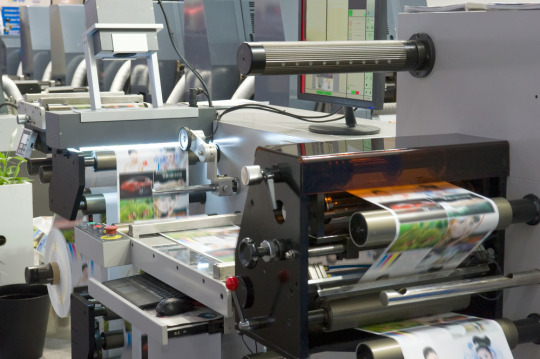
the printing industry is now a dynamic field shaped by technological advancements, changing consumer behaviors, and evolving market demands. This article explores the current state of the printing industry, delving into the demand factors that drive its growth and adaptation.
I. Historical Perspective:
To understand the current demand for the printing industry, it is essential to trace its historical evolution. Traditionally, printing was dominated by analog processes, including letterpress and offset printing. These methods were instrumental in disseminating information through newspapers, magazines, and books. However, the advent of digital technologies, particularly the internet, marked a paradigm shift in communication and information dissemination.

II. Technological Advancements:
a. Digital Printing: The rise of digital printing technologies has been a game-changer for the industry. Digital printing allows for shorter print runs, variable data printing, and quicker turnaround times. This flexibility has made it more cost-effective for businesses to produce personalized and on-demand print materials, catering to niche markets and individualized consumer preferences.
b. 3D Printing: In recent years, 3D printing has emerged as a revolutionary technology with implications across various industries. While not traditionally associated with the printing sector, 3D printing enables the production of three-dimensional objects layer by layer. This technology has found applications in prototyping, manufacturing, healthcare, and even construction, expanding the horizons of the printing industry.
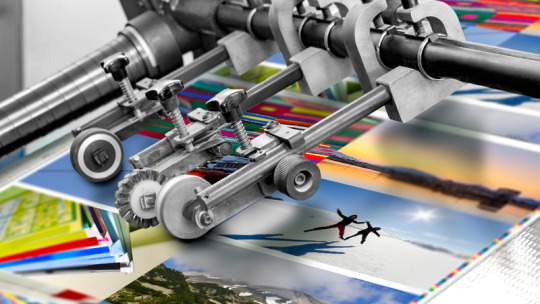
III. Market Trends and Dynamics:
a. Packaging: The demand for printed packaging has witnessed substantial growth, driven by the e-commerce boom and the increasing need for visually appealing product packaging. Printers play a crucial role in creating eye-catching labels, boxes, and packaging materials that enhance brand visibility and influence consumer purchasing decisions.
b. Sustainable Printing: Environmental concerns have become a significant factor influencing consumer behavior and corporate practices. The printing industry has responded by embracing sustainable practices, including the use of eco-friendly inks, recycled paper, and energy-efficient printing processes. Sustainable printing has become a key selling point for businesses aiming to reduce their ecological footprint.

c. Personalization: Consumers today seek personalized experiences in all aspects of their lives, including print materials. The printing industry has capitalized on this trend by offering customized products, such as personalized books, calendars, and promotional materials. Variable data printing allows for the incorporation of individualized content, addressing the growing demand for unique and tailored printed items.
IV. Print vs. Digital: Finding the Balance
a. Coexistence of Print and Digital: While digital technologies have transformed communication, print media has not become obsolete. Instead, there is a growing recognition of the complementary roles played by print and digital formats. Print materials offer a tangible and tactile experience that digital content cannot replicate. Businesses and marketers are increasingly adopting integrated strategies that leverage both print and digital channels to reach a broader audience.

b. Print in the Digital Marketing Mix: Printed materials continue to hold a significant place in marketing strategies. Direct mail, brochures, and promotional materials remain effective in conveying a brand’s message and establishing a physical connection with consumers. The unique qualities of print, such as texture and color depth, contribute to creating memorable and impactful marketing collateral.
V. Challenges and Opportunities:
a. Economic Factors: The printing industry is not immune to economic fluctuations. Economic downturns can lead to reduced advertising budgets, impacting the demand for printed marketing materials. On the other hand, economic recovery and growth can stimulate business activities, prompting increased investment in print advertising and promotional campaigns.
b. Digital Competition: The rise of digital alternatives poses a challenge to the printing industry. Online platforms, social media, and digital advertising offer cost-effective and highly targeted ways to reach audiences. Printers must adapt by offering unique value propositions, such as high-quality printing, specialty finishes, and personalized services that differentiate them from digital alternatives.
c. Technological Disruption: While technological advancements present opportunities, they also pose challenges for traditional printing methods. As 3D printing and digital technologies continue to evolve, printers must invest in updating their equipment and skills to stay competitive. Embracing automation and artificial intelligence in print workflows can enhance efficiency and reduce costs.
VI. Future Outlook:
a. 3D Printing’s Role: The integration of 3D printing into mainstream manufacturing processes is expected to reshape the printing industry further. From producing prototypes to creating custom products on-demand, 3D printing holds the potential to revolutionize the way goods are designed and manufactured.
b. Augmented Reality (AR) and Print: Augmented Reality has the potential to merge the physical and digital worlds, offering interactive and immersive experiences. Print materials augmented with AR can provide additional layers of information, making them more engaging for consumers. This integration may open new avenues for creativity and innovation in the printing industry.
c. Continued Emphasis on Sustainability: As environmental concerns continue to gain prominence, the printing industry’s commitment to sustainability is likely to grow. Printers may increasingly adopt eco-friendly practices, and consumers may show a preference for products with environmentally conscious printing processes.
Conclusion:
The printing industry‘s demand is intricately tied to technological advancements, market trends, and evolving consumer preferences. While challenges persist, the industry has demonstrated resilience by embracing innovation and adapting to changing dynamics.

As we move forward, the coexistence of traditional and digital printing methods, coupled with a commitment to sustainability and personalized experiences, will shape the future of the printing industry. The key lies in finding the right balance between technological innovation and timeless print qualities to meet the diverse demands of a rapidly evolving landscape.
#3d printing#3d sign#3d signage#signage#branding#poster#printing company#print on demand services#print on demand#digital art#pod#print on demand company#print on demand in India
3 notes
·
View notes
Text
DIY Postage Stamp Coasters

Project by Kate Pruitt:
I’m getting ready to go running off to complete the zillion post-holiday errands I have on my plate, but I decided I simply must add the supplies for this project to my shopping list. Jessica is a graphic designer by trade, which is clear to see from her choice of prints for these adorable coasters that she whipped up in no time. Jessica found these images on the Flickr site of Karen Horton. Karen has amassed a treasure trove of amazing images of old postage stamps and labels. With a few simple materials, Jessica fashioned these “jumbo stamp” fabric coasters, complete with perfectly pinked edges.
This is the perfect project for a laid-back weekend, especially because Jessica and Karen have graciously made the stamp designs available for download. I can’t wait to make little sets of these for holiday gifts as I huddle next to my space heater:) Thank you for sharing your awesome project, Jessica! And thank you to Karen for sharing your images as well. —Kate

Materials:
White felt
White cotton fabric
Iron-on transfer paper, available at office supply stores
Postage stamp images
White thread
Computer and printer
Iron
Scissors
Pinking shears
Pins
Needle or sewing machine
Instructions:
1. To make the coasters pictured here, download the printable 2-page PDF and skip to step 3. If using your own images, scale each postage stamp to approximately 4″ x 4″.(note: images in PDF are reversed so they will transfer properly)
2. Reverse each stamp to create a mirror image. Many printers have a setting called “flip horizontal” that will reverse the image, or use your software application’s settings.
3. Print the stamps onto the iron-on transfer paper.
4. Following the instructions on the transfer paper package, iron the images onto white cotton fabric and remove the paper backing.

5. Pin the printed fabric to the felt and stitch around the edges of each stamp image.
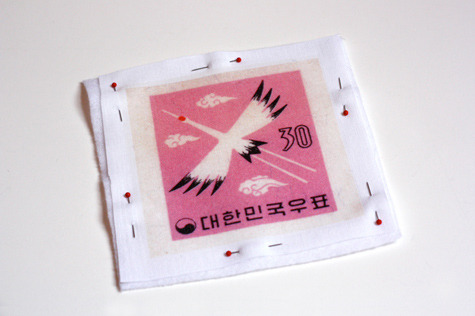
6. Trim the stamp with a pinking shears to create a border with a perforated look.

YOU’RE DONE!

5 notes
·
View notes
Text
EXPLORING THE 5 COOL PARTNER SELLER ELECTRONICS PRODUCTS-Part1
Exploring the 5 Cool Partner Seller Electronics Products
Prologue
Are you an electronics enthusiast looking to expand your electronics project repertoire? Want to take your skills to the next level by exploring new and exciting products? Look no further than our list of five cool electronics products from partner sellers!
Whether you’re interested in building your own smart home devices, experimenting with sensors, or creating your own robot, these products are sure to inspire you. They cover a lot of application areas, from loop detectors used to monitor vehicle count in parking garages to Arduino CNC shields used in CNC machines, from simple pulse sensors used to detect cardiovascular pulse signals from fingertip to RGB LED panel light used in smart home, these products are unique, compact, and functional. Not only are these products fun to build and use but they’re also designed to help you learn new skills and techniques along the way.
What’s more, these products all come from trusted partner sellers who are committed to developing high-quality products. They’re happy to provide technical support for customers who have questions, so you can be sure you’re getting the best in electronics.
So get ready to dive into the world of electronics and explore these five cool partner seller products. You’re sure to find something that piques your interest and takes your own electronics projects to the next level.
Inductive Loop Vehicle Detector by Elektronika-ba
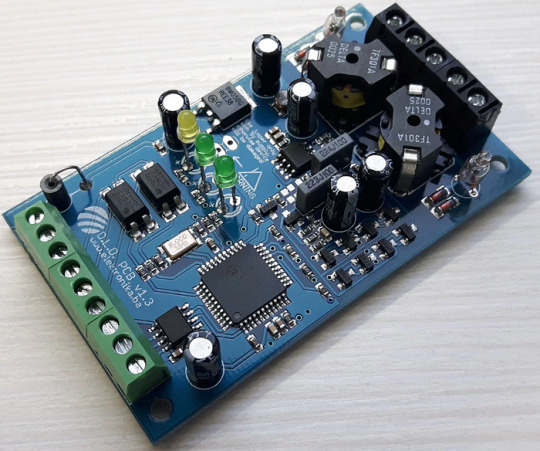
Whether you need to monitor occupancy and count vehicles in parking garages, control vehicle access at door and barrier controls, or facilitate traffic light installations and traffic controllers, the inductive loop detector is the perfect solution. It can even detect the direction and speed of vehicle traffic, making it an invaluable tool for a variety of traffic-related applications. In addition, this device can function as a stand-alone speed trap and can be easily interfaced with Arduino.
We can also provide a pre-programmed PIC chip to meet your project requirements.
Specifications
Number of operating modes: 4
Tuning: Automatic
Detection type: Presence/Pulse
Presence time: Adjustable in 3 steps
Pulse duration: 250 ms / 500 ms
Signal filtering: Adjustable in 2 steps (NORMAL, HIGH)
Loop inductance: 20 uH — 1000 uH
Frequency range: 20 kHz — 145 kHz
Frequency selection: 2 combinations (LOW, HIGH)
Sensitivity: Maximum 0.0025% Δf/f, adjustable in 8 steps
Detection speed: 10 ms by default, adjustable
Start-up time: ~ 1 second per channel (or longer if the frequency is not stable)
Temperature range: -35°C — 120°C
Sensor protection: Galvanic isolation + gas discharge tube for lightning protection
Don’t settle for less — click here to learn more about the Inductive Loop Vehicle Detector and experience the compact, yet cool detector!
Arduino CNC Shield V3.51 by Protoneer
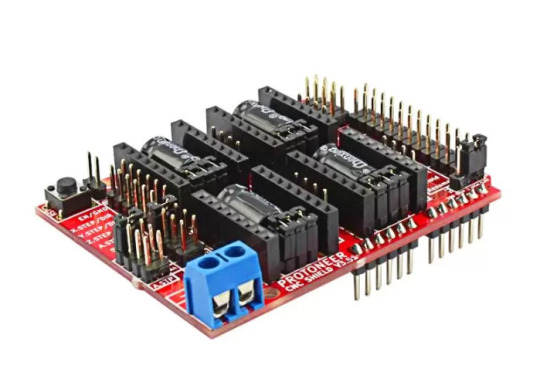
Designed by Protoneer, this kit is packed with features to ensure high precision control of your stepper motors, you can use it to easily build small CNC routers, DIY laser cutters, 3D printers, or any project that requires precise stepper motor control.
Our latest version 3.51 includes several enhancements to make assembly and installation even easier. We’ve added end-stop and probe signal filtering circuitry to eliminate false triggers and allow the use of unshielded cables for end-stops and probes. We’ve also increased the size of the solder pads for easier assembly and updated the probe pin labels to make installation a breeze.
With the Arduino CNC Shield Kit, you’ll have everything you need to build your own CNC router or mill with ease.
Features
Includes Noise Filers on all end stops and the probing pin. (New in V3.51)
GRBL 0.9 compatible. (Open source firmware that runs on an Arduino UNO that turns G-code commands into stepper signals https://github.com/grbl/grbl)
4-Axis support (X, Y, Z, A-Can duplicate X, Y, Z or do a full 4th axis with custom firmware using pins A4 and A3)
2 x End stops for each axis (6 in total)
Coolant enable
Uses removable Pololu A4988 compatible stepper drivers. (A4988, DRV8825 and others)(Not Included)
Jumpers to set the Micro-Stepping for the stepper drivers. (Some drivers like the DRV8825 can do up to 1/32 micro-stepping )
Compact design.
Stepper Motors can be connected with 4-pin molex connectors or soldered in place.
Runs on 12–36V DC. (At the moment only the Pololu DRV8825 drivers can handle up to 36V so please consider the operation voltage when powering the board.)
Don’t wait — click here to see more about the Arduino CNC Shield V3.51 and start your next project today!
Easy Pulse Mikro by Embedded Lab
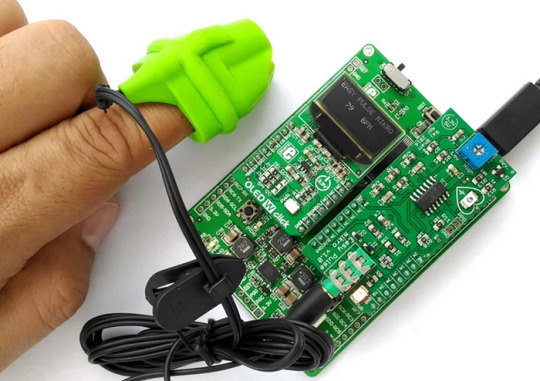
What’s more, the Easy Pulse Mikro is designed in the convenient Mikro bus form factor, making it easy to integrate with a wide range of mikroElektronika’s development boards. With all necessary instrumentation and amplification built right in, this powerful sensor provides a clean and precise analog PPG waveform output that’s routed to the AN pin of the mikroBus connector.
Whether you’re a hobbyist, student, or professional developer, the Easy Pulse mikro is the perfect tool for monitoring heart rate and other vital signs.
Click here to see more about the Easy Pulse mikro.
Features
Compatible with mikroBus socket.
Filtered and amplified analog PPG signal output
On-board potentiometer for adjusting amplifier gain, if needed (rotate clock-wise for increasing gain)
Onboard LED for indicating heartbeat. It flashes synchronously with the heartbeat on detecting the pulse from the fingertip.
2 notes
·
View notes
Text
App Showcase: Navigator
The Asspull IIIx Navigator is built into the system BIOS and provides disk management features.
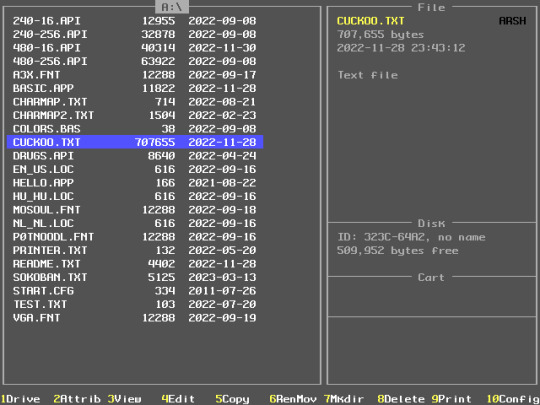
(Seen above: the main Navigator screen in the middle of a redesign. To the left is a list of files, which is supposed to be several columns of only names. To the right is information about the currently selected file and the disk it's on, and blank panels for information on any cartridge that may be inserted and the system itself.)
All actions except for entering a directory or running an application may be executed via the function key bar along the bottom, though several aren't available just yet.
Change which drive to show.
Change the selected file's attributes (the black letters in the top right corner).
View the file — the Enter key also works so I might remove this to make room for another feature.
Edit the file — only plain text files can be edited though.
Copy the selected file to another path.
Rename or move the selected file.
Make a new directory.
Delete the selected file.
Print the selected file. This only works on plain text files (though there are some escape codes) because of the A3X's companion printer's limitations.
Change the system configuration
Holding the Alt key, this changes:
Copy the diskette.
Format it.
Change its volume label.
?
?
?
?
?
Change the system time.
See detailed system information.
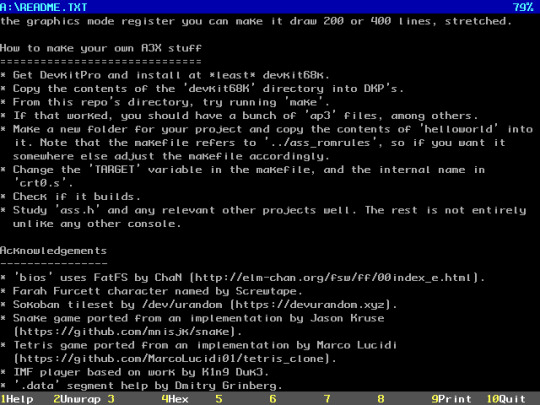

(Seen above: the text file viewer in plain and hex modes.)
API files are AssPull Images, a bespoke format. The Navigator can view them, with full support for all the format's features, because this is a BIOS function.
FNT files are... exactly that. Fonts. There is no real viewer per se, but trying to do so will load that font into VRAM, replacing the default until a restart.
LOC files are Locale information. Again, there's no real viewer, but like fonts you can just press Enter to activate them. This changes the names of months and days, currency, time and date formats, and keyboard mapping.

(Seen above: the work-in-progress editor based on kilo. A custom font, mOsOul, has been loaded beforehand.)
START.CFG specifically lets you preload a font and/or locale on boot, before the Navigator even gets a turn.
There's also a screensaver. It's Starfield, from Windows.
2 notes
·
View notes
Text
Health Supplements Labels Printing in Jaipur: Enhancing Brand Identity

In the rapidly growing health and wellness industry, health supplements have taken center stage, offering everything from vitamins and minerals to herbal extracts and protein powders. As the demand for these products continues to rise, the importance of professional health supplements labels printing in Jaipur becomes increasingly evident. High-quality labels not only provide essential information to consumers but also play a critical role in branding, marketing, and regulatory compliance.
The Growing Market for Health Supplements in Jaipur
Jaipur, known for its rich cultural heritage and emerging business landscape, is also witnessing significant growth in the health and wellness sector. With increasing awareness about personal health, fitness, and preventive healthcare, many businesses have ventured into the manufacturing and marketing of dietary supplements. In such a competitive market, the presentation of a product becomes crucial, making health supplements labels printing in Jaipur a vital service for local brands.
Why Labels Matter in Health Supplements
Labels are more than just decorative elements. They communicate crucial information such as:
Nutritional content
Dosage instructions
Ingredients
Allergen warnings
Manufacturing and expiry dates
Certifications (e.g., FSSAI, ISO, Organic)
A well-designed label helps establish trust with consumers by ensuring that the product is transparent and credible. Investing in professional health supplements labels printing in Jaipur ensures that all this information is clearly and attractively presented, giving a competitive edge to your product.
Key Features of Effective Supplement Labels
For a health supplement label to be effective, it must strike the perfect balance between aesthetics and functionality. Here are some features that leading health supplements labels printing in Jaipur services focus on:
High Print Quality: Sharp, vibrant colors and clear fonts help your product stand out on shelves.
Durable Material: Labels should be resistant to moisture, UV exposure, and wear-and-tear, especially for products that may be stored for long periods.
Custom Shapes & Sizes: Tailored labels fit various bottle types and packaging styles.
Tamper-Proof Seals: Added security features enhance consumer trust.
Compliance Ready: Adherence to Indian and international labelling norms (like FSSAI and GMP).
Customization Options Available in Jaipur
Printing companies in Jaipur offer a wide range of customization options to help brands create unique, eye-catching designs. Whether you're aiming for a sleek, eco-conscious design or a vibrant, eye-catching label, local designers and printers can work with you to bring your vision to life.
Foil Stamping & Embossing: Adds a premium touch to labels.
Transparent & Matte Labels: Great for sleek, modern packaging.
Multi-Layer Labels: Ideal for products that require detailed instructions or multilingual information.
QR Codes & Barcodes: Enhances digital engagement and inventory tracking.
These advanced customization options offered through health supplements labels printing in Jaipur can significantly elevate your brand’s visibility and professionalism.
Regulatory Considerations
The Food Safety and Standards Authority of India (FSSAI) mandates specific labeling requirements for dietary supplements. This includes the display of nutritional facts, daily dosage, allergen information, and warning statements where applicable. Engaging a reliable service provider for health supplements labels printing in Jaipur ensures that your product meets all necessary legal requirements, thereby reducing the risk of recalls or penalties.
Local Advantages of Printing in Jaipur
Opting for local health supplements labels printing in Jaipur has several advantages:
Cost Efficiency: Local sourcing reduces transportation and logistics costs.
Faster Turnaround: Being geographically closer speeds up the design and delivery process.
Personalized Service: Face-to-face consultations with designers and print technicians ensure that your exact needs are met.
Support Local Economy: Partnering with Jaipur-based businesses promotes regional economic growth.
Finding the Right Printing Partner
When looking for a health supplements labels printing in Jaipur service, consider these factors:
Experience in Supplement Labeling: Choose a printer who understands the industry-specific needs.
Portfolio of Work: Review past projects to assess design and print quality.
Customer Reviews: Look for testimonials from other supplement brands.
Scalability: Make sure the provider can handle both small and large batch orders.
Conclusion
As the demand for health and dietary supplements continues to surge in India, standing out in the marketplace has never been more important. Professional health supplements labels printing in Jaipur offers an effective way to elevate your product’s visual appeal, build consumer trust, and ensure regulatory compliance. Whether you are a new startup or an established brand, investing in high-quality labels is an essential step towards long-term success in the health supplement industry.
By choosing local and experienced label printing services in Jaipur, you not only enhance your product’s credibility but also contribute to the vibrant business ecosystem of the Pink City.
0 notes
Text
Barcode Definition: 5 Types & Common Applications You Should Know

In today’s digital-first business landscape, speed and accuracy are no longer optional—they're essential. Barcodes are one of the simplest yet most powerful technologies that help companies track, manage, and optimize inventory. Understanding the barcode definition in 2025 is vital for businesses aiming to boost productivity, streamline processes, and reduce errors. At AIDC Technologies India, we empower businesses with the right barcode solutions that fit industry-specific needs.
What is a Barcode? A Simple Barcode Definition
The barcode definition refers to a machine-readable visual representation of data that is typically used to identify and manage products, items, or assets. A barcode is made up of a series of black and white lines or patterns that store information such as product codes, serial numbers, or pricing.
When scanned using a barcode reader, the information is instantly retrieved and processed by a software system. This simple yet powerful technology is used in everything from grocery billing to industrial warehouse management. At AIDC Technologies India, we help businesses apply the barcode definition in real-world environments with customized solutions.
Components of a Barcode System: From Scanners to Software
To understand the practical application of the barcode definition, you need to know the main components of a barcode system:
Barcode Labels – Printed tags or stickers containing barcodes.
Barcode Scanners – Devices that read the barcode and capture the information.
Software – Systems that process and organize barcode data.
Printers – Tools used to generate barcode labels for different items.
AIDC Technologies India provides complete barcode systems—integrating hardware and software to create end-to-end tracking and identification solutions. Our offerings ensure seamless operation and high accuracy.
5 Types of Barcodes You Should Know
Understanding the barcode definition means recognizing the different types of barcodes and their specific uses. Here are five popular barcode types used widely in 2025:
UPC (Universal Product Code): One of the most recognized barcode types, used mainly in retail for identifying products at checkout.
QR Code (Quick Response Code): A 2D barcode that stores more data, including URLs, contact details, and payment info—commonly used in marketing and mobile apps.
Data Matrix: A compact 2D barcode used in healthcare, electronics, and manufacturing for marking small items and components.
PDF417: A stacked linear barcode that can store large amounts of data, often used in identification cards and travel documents.
Code 128: A high-density barcode ideal for logistics and shipping labels where space is limited but data needs to be precise.
AIDC Technologies India helps clients choose the most appropriate barcode type based on their industry, product, and operational needs.
Real-World Applications of Barcodes Across Industries
The barcode definition is best understood when you see how it works in real business environments. Here are key industry applications:
Retail: Barcodes enable fast checkout, accurate billing, and real-time inventory updates.
Healthcare: Used for patient ID, tracking medication, and managing medical supplies.
Logistics and Warehousing: Ensures precise inventory control, package tracking, and delivery verification.
Manufacturing: Tracks raw materials, components, and final products across the supply chain.
Education and Libraries: Helps track books, student materials, and assets in schools and universities.
At AIDC Technologies India, we design barcode systems to fit each industry’s specific requirements, ensuring compliance, accuracy, and operational ease.
Benefits of Barcode Technology for Businesses
Adopting the barcode definition into daily operations comes with multiple advantages:
Accuracy: Reduces manual errors during data entry.
Speed: Instant scanning improves customer service and operational efficiency.
Inventory Control: Provides real-time visibility into stock levels.
Cost Savings: Minimizes waste, reduces losses, and saves on labor.
Traceability: Enables complete tracking of products from source to delivery.
Our clients at AIDC India experience these benefits firsthand through custom-tailored barcode implementation strategies that enhance both scalability and efficiency.
How AIDC Technologies India Powers Barcode Solutions
AIDC Technologies India provides end-to-end support for barcode implementation, including system consultation, hardware deployment, software integration, training, and post-sale support.
We ensure that our clients not only understand the barcode definition but also experience its full power in their daily workflows. Whether you need barcode printers for product labels or scanners integrated with your ERP system, we make the process seamless. Our industry experience allows us to handle barcode projects for retail, warehousing, manufacturing, and more with high precision and scalability.
Barcode Technology Trends to Watch in 2025
The barcode definition continues to expand as technology evolves. In 2025, several key trends are influencing the future of barcode use:
Mobile Scanning: Smartphones are increasingly used for reading barcodes in retail and field operations.
Cloud Integration: Barcode systems are now cloud-enabled for real-time data access across locations.
Sustainable Labeling: Eco-friendly label materials are gaining popularity.
AI Integration: Barcode data is used to train AI for predictive analytics and smart inventory planning.
Hybrid Tracking: Combining barcodes with RFID for layered tracking and better asset management.
AIDC India stays updated with these trends to ensure our clients are equipped with future-ready barcode solutions.
Conclusion: Unlock Efficiency with AIDC's Barcode Solutions
The barcode definition may seem basic, but its impact is powerful and far-reaching. With the right barcode system in place, businesses can achieve better control, faster processes, and increased customer satisfaction. From small retail stores to massive industrial operations, barcodes play a key role in digital transformation.
AIDC Technologies India is here to support you in your barcode journey. We offer professional-grade hardware, custom software integration, and expert consulting to ensure your business gets the best results from barcode technology.
Call to Action
Looking to boost your business with barcode technology? Partner with AIDC Technologies India for reliable, scalable, and industry-specific barcode systems.
#BarcodeDefinition2025#TypesOfBarcodes#BarcodeApplications#BarcodeTechnology#BarcodeSolutions#SmartBarcodeUses#BarcodeInBusiness#AIDCBarcode
0 notes
Text
Label Printer Machine: The Ultimate Guide for Efficient and Professional Product Labeling

What is a Label Printer Machine?
A label printer machine is a device that prints custom or standardized labels for products, containers, cartons, and shipping packages. It can print on paper, plastic, thermal material, or synthetic labels using technologies like thermal transfer, direct thermal, or inkjet. Label printer machines are essential in packaging, inventory management, retail, pharmaceuticals, logistics, and food processing.
Types of Label Printer Machines
1. Thermal Transfer Label Printers
These use heat to transfer ink from a ribbon onto the label. Ideal for long-lasting, waterproof, smudge-resistant labels, commonly used in pharmaceuticals, electronics, and industrial labeling.
2. Direct Thermal Label Printers
No ribbon is used; heat-sensitive label paper darkens when heated. Best for short-term applications like shipping labels, receipts, and food packaging.
3. Inkjet Label Printers
Produce high-resolution, colorful labels. Suitable for custom branding, marketing labels, and retail packaging.
4. Laser Label Printers
Offer speed and sharpness. Used when mass label printing is needed, especially for office or warehouse environments.
5. Portable Label Printers
Handheld or mobile devices used in field service, retail, logistics, and inventory control.
6. RFID Label Printers
Print and encode RFID tags and barcodes for real-time tracking and supply chain automation.
Common Applications Across Industries
1. Food and Beverage
Nutritional labels, expiry dates, batch codes
Tamper-evident and waterproof labels
2. Pharmaceuticals
Regulatory-compliant labels with dosage info, QR codes, batch numbers
High print precision and barcode clarity
3. Cosmetics
High-resolution brand and ingredient labels
Sleek, colorful, water-resistant finishes
4. Manufacturing
Asset labels, compliance tags, quality control stickers
5. Logistics and Warehousing
Shipping and barcode labels
SKU and inventory management tags
6. Retail
Price tags, promotional stickers, and shelf labels
Key Features of High-Quality Label Printer Machines
1. Print Resolution
Measured in DPI (dots per inch). For clear text and barcodes, 203 DPI is standard, while 300–600 DPI is used for high-definition images and small text.
2. Print Speed
Ranges from 2 to 14 inches per second (IPS). Higher speeds are ideal for bulk printing operations.
3. Connectivity Options
USB, Ethernet, Bluetooth, Wi-Fi—essential for integration with POS systems, warehouse management software, or industrial PLCs.
4. Media Compatibility
Should support a variety of label rolls: paper, PET, PP, BOPP, synthetic, glossy, and matte.
5. Software Integration
Compatibility with label design software like BarTender, NiceLabel, or ZebraDesigner.
6. Auto-Cutter and Peeler
Helps in high-speed workflows by automatically cutting or peeling off printed labels.
Advantages of Using a Label Printer Machine
Professional Packaging: Clean, precise labels reflect product quality
Customization: Easily print logos, barcodes, and QR codes on demand
Efficiency: Reduce dependency on pre-printed labels and minimize stockouts
Compliance: Meet legal labeling requirements effortlessly
Traceability: Boost product tracking across supply chains
Cost-Saving: In-house label printing reduces outsourcing costs
0 notes
Text
Self Adhesive PET Materials
Experience superior performance with Self-Adhesive PET Material, a premium polyester film designed for a wide range of applications. Known for its durability, flexibility, and high-quality finish, this material offers strong adhesion, making it perfect for labels, decals, and more.
Key Features:
Durable & Tear-Resistant: Ideal for both indoor and outdoor use, providing lasting protection and performance.
Strong Adhesion: Adheres securely to a variety of surfaces, including glass, metal, plastic, and paper.
Waterproof & Fade-Resistant: Perfect for labels and graphics exposed to moisture, sunlight, or wear.
Smooth Surface for Crisp Printing: Compatible with inkjet, laser, and UV printers for sharp, vibrant designs.
Flexible & Easy to Apply: Conforms easily to curved or uneven surfaces without bubbles or wrinkles.
Perfect for high-performance labeling, packaging, product branding, and custom decals, Self-Adhesive PET Material ensures a professional look and long-lasting durability. Enhance your projects with this versatile, high-quality material today!
Our Self-Adhesive PET (Polyester) Materials are designed for superior strength, chemical resistance, and excellent printability, making them ideal for industrial labeling, branding, product packaging, and outdoor applications. With outstanding dimensional stability and environmental resistance, these materials ensure long-lasting performance even in harsh conditions.

0 notes